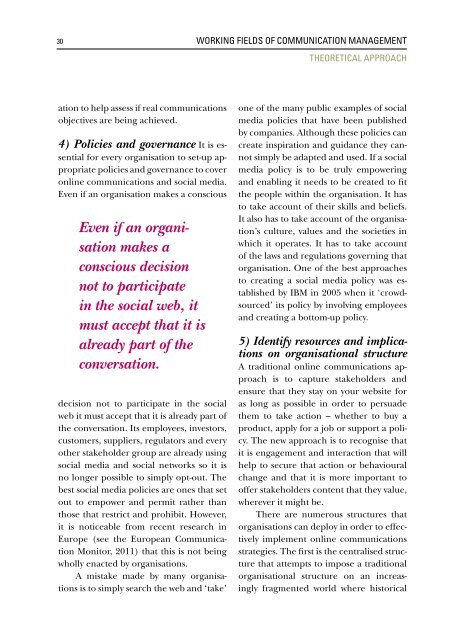Now availiable - Digital Communication Awards
Now availiable - Digital Communication Awards
Now availiable - Digital Communication Awards
You also want an ePaper? Increase the reach of your titles
YUMPU automatically turns print PDFs into web optimized ePapers that Google loves.
30<br />
ation to help assess if real communications<br />
objectives are being achieved.<br />
4) Policies and governance It is essential<br />
for every organisation to set-up appropriate<br />
policies and governance to cover<br />
online communications and social media.<br />
Even if an organisation makes a conscious<br />
Even if an organisation<br />
makes a<br />
conscious decision<br />
not to participate<br />
in the social web, it<br />
must accept that it is<br />
already part of the<br />
conversation.<br />
decision not to participate in the social<br />
web it must accept that it is already part of<br />
the conversation. Its employees, investors,<br />
customers, suppliers, regulators and every<br />
other stakeholder group are already using<br />
social media and social networks so it is<br />
no longer possible to simply opt-out. The<br />
best social media policies are ones that set<br />
out to empower and permit rather than<br />
those that restrict and prohibit. However,<br />
it is noticeable from recent research in<br />
Europe (see the European <strong>Communication</strong><br />
Monitor, 2011) that this is not being<br />
wholly enacted by organisations.<br />
A mistake made by many organisations<br />
is to simply search the web and ‘take’<br />
WORKING FIELDS OF COMMUNICATION MANAGEMENT<br />
THEORETICAL APPROACH<br />
one of the many public examples of social<br />
media policies that have been published<br />
by companies. Although these policies can<br />
create inspiration and guidance they cannot<br />
simply be adapted and used. If a social<br />
media policy is to be truly empowering<br />
and enabling it needs to be created to fit<br />
the people within the organisation. It has<br />
to take account of their skills and beliefs.<br />
It also has to take account of the organisation’s<br />
culture, values and the societies in<br />
which it operates. It has to take account<br />
of the laws and regulations governing that<br />
organisation. One of the best approaches<br />
to creating a social media policy was established<br />
by IBM in 2005 when it ‘crowdsourced’<br />
its policy by involving employees<br />
and creating a bottom-up policy.<br />
5) Identify resources and implications<br />
on organisational structure<br />
A traditional online communications approach<br />
is to capture stakeholders and<br />
ensure that they stay on your website for<br />
as long as possible in order to persuade<br />
them to take action – whether to buy a<br />
product, apply for a job or support a policy.<br />
The new approach is to recognise that<br />
it is engagement and interaction that will<br />
help to secure that action or behavioural<br />
change and that it is more important to<br />
offer stakeholders content that they value,<br />
wherever it might be.<br />
There are numerous structures that<br />
organisations can deploy in order to effectively<br />
implement online communications<br />
strategies. The first is the centralised structure<br />
that attempts to impose a traditional<br />
organisational structure on an increasingly<br />
fragmented world where historical




